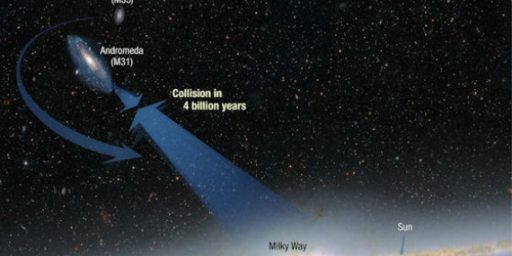Scientists: At Least 8.8 Billion Earth-Size Planets In Milky Way
The earth-like planets are out there, but it's unclear if the life is.
Scientists are saying that the number of habitable planets in just our own galaxy may not be as small as previously believed:
WASHINGTON — Space is vast, but it may not be so lonely after all: A study finds the Milky Way is teeming with billions of planets that are about the size of Earth, orbit stars just like our sun, and exist in the Goldilocks zone — not too hot and not too cold for life.
Astronomers using NASA data have calculated for the first time that in our galaxy alone, there are at least 8.8 billion stars with Earth-size planets in the habitable temperature zone.
The study was published Monday in the journal Proceedings of the National Academy of Sciences.
For perspective, that’s more Earth-like planets than there are people on Earth.
As for what it says about the odds that there is life somewhere out there, it means “just in our Milky Way galaxy alone, that’s 8.8 billion throws of the biological dice,” said study co-author Geoff Marcy, a longtime planet hunter from the University of California at Berkeley.
The next step, scientists say, is to look for atmospheres on these planets with powerful space telescopes that have yet to be launched. That would yield further clues to whether any of these planets do, in fact, harbor life.
The findings also raise a blaring question, Marcy said: If we aren’t alone, why is “there a deafening silence in our Milky Way galaxy from advanced civilizations?”
(…)
And the 8.8 billion Earth-size planets figure is only a start. That’s because scientists were looking only at sun-like stars, which are not the most common stars.
An earlier study found that 15 percent of the more common red dwarf stars have Earth-size planets that are close-in enough to be in the not-too-hot, not-too-cold Goldilocks Zone.
Put those together and that’s probably 40 billion right-size, right-place planets, Marcy said.
And that’s just our galaxy. There are billions of other galaxies.
To answer the question the article poses, the fact that a planet may support life doesn’t mean it supports intelligent life, and the fact that it might support intelligent life, ddoesn’t mean those life forms are at a stage where they are producing detectable radio transmissions. Our planet is some 4.5 billion years old and it took almost a billion years for even simple single celled organisms to arise. Our human predecessors didn’t exist until 2.5 million years ago, and modern humans are only about 200,000 years old. The first radio transmission, outside of extremely low-level experimental transmission, was less than 100 years ago, meaning that even the earliest low-level radio transmissions from Earth are only detectable 100 light years away. It seems likely that the evolution of life, assuming it did take place on a different “earth-like” planet has or is following a similar evolutionary time scale. In some cases, the process likely ends long before life evolves to a state of intelligence, whether it’s because of some natural phenomenon or a disaster from elsewhere such as a comet or meteor strike. In other cases, the process may have started long after it did here on Earth. And in those cases where it could have started long before, it’s possible that there’s some form of intelligent life that either doesn’t or can’t communicate in a manner that can be detected on an interstellar level. In other words, finding planets where life can exist is fast becoming the easy part of the job, finding planets where it does exist is going to be an entirely different story, and a mystery to which we may not know the answer or a very long time to come.
Given all that, the “deafening silence” seems pretty easy to understand.
Illustration of Earth-like planet via NASA







Did you see that about 8 billion of them are estimated to have a sensible plan for National Health?
Also, anyone more technologically advanced than us may want to make certain we’re going to develop a more rational method of interacting with each other before they let us loose from our playpen.
First we had better show we have enough smarts not to destroy our own cradle….
@grumpy realist:
My personal opinion is that, if there are other civilizations out there, we are all isolated by immense distances of scale and time.
(Someone owns this answer to the Fermi’s Paradox, forget who.)
@john personna:
That strikes me as thoroughly plausible. Unless FTL travel is possible, it strikes me as the most plausible answer. And from what I can gather, unless our current understanding of physics has a massive, gaping hole in it, FTL is a pipe dream.
In “The mote in God’s Eye” Larry Niven and Jerry Pournelle explored the possibilities of what the discovery of intelligent alien life would mean for earth bound religions. An interesting experiment that did not come to a neat and easy resolution.
@grumpy realist: IIRC Ray Bradbury explored this exact angle in a short story (forget the title). In his version, 2 aliens of the far more advanced galactic civilizations have been tasked with the onerous duty of starting a nuclear war because we had not yet done it. All civilizations go thru a cycle of technological advances to the point where they almost destroy themselves, then become far more passive, and then and only then are they welcomed into the galactic family.
I won’t say how it ends, but it is a good read.
i probably meant “immense scales of distance and time,” but whatever.
@john personna: This.
@Rob in CT: I remember reading a paper at one point postulating how one could get FTL-like effects without breaking the laws of physics. It can be done, but the rest of the engineering required….well, let’s say you’ve got to be able to sling the equivalent of black holes around.
Now if you were able to seat yourself on an asteroid and propel yourself via a mass-driver at 1g, you could get to a lot of interesting places during your lifetime due to relativistic effects–but you’d have to have a target picked out. Not really usable for casual stopping by.
Heck, I’d settle for a permanent manned base on Mars at this point.
Looking at the Drake Equation:
I remember when I was reading about SETI, that the last factor “L” is really the key. How much time does a civilization really get between when they develop the technology to communicate beyond their galaxy, and developing the technology to destroy themselves?
There you go again – listening to “scientists” using “data” and “facts”. Aren’t these the same people trying to convince us the world is millions of years old and the earth is warming? Why would I listen to them? Where in the Bible does it mention all these other planets?
You think I’m kidding? I’ll bet we start seeing articles like that any day now.
@grumpy realist:
Speaking of science fiction, I believe it was one of Vernor Vinge’s ideas, some years ago, that as person-to-person networking grew on earth, the ability to leave went down. No one wanted to sign off, as it were. I think some of his Across Realtime time skippers were drafted for a near-solar project, because no one wanted to be even that far away, and suffer the network delay.
It was a very early notice of the internet as a force tying down.
So, why the heck Mars?
If it is only a false premise that getting to Mars gets us “closer” to those stars, no. IMHO.
(tldr – virtual worlds trump mars)
@john personna:
So wait a second, are you staying it won’t be like “Star Trek” and that we will never be able to walk into a bar like Jabba the Hut’s place on Star Wars? Say it ain’t so!
I’m still going to hold out for the dream. I still think we’ll be able to crack the FTL puzzle, unlikely as it seems now. As Arthur C. Clarke said: “We will think of something.” We’ve been doing that since the first man chipped out the first stone tool.
Sure. Just look at Earth.
@stonetools:
We had a time that was almost exactly like Star Trek, with ships voyaging great distances to encounter incomprehensible humanoid cultures.
Adventures at Sea in the Great Age of Sail: Five Firsthand Narratives
The parallels to Star Trek are shocking (and lead me to believe the writers had some exposure)
As far as adventures to come … VR and immersive worlds are a more likely route, IMHO. I mean they are hard, but not FTL level hard.
8.8 billion? That means that there is a least one out there that is suitable for relocation of the Republican Party.
@al-Ameda:
Somalia’s closer, and operates on sound free market principles.
@john personna:
I just checked OECD statistics on this, and the actual number of planets where there is estimated to be a ‘sensible plan for National Health’ is 8,799,999,999.9
If they don’t have lightsabers, replicators, or a holodeck, what good are they to me?
With the Internet anything is possible! Let’s Time Travel back to 1977!
http://www.liveleak.com/view?i=e6a_1209348047
Thank You Richard Pryor. RIP
(Yes he says it. Apparently 36 years ago NBC was’t so concerned about offending anyone.)
@john personna: Sounds interesting. I’ll have to check that out. Here’s one back at you: Endurance: Shackleton’s Incredible Voyage
If you haven’t read it yet, do.
@Todd:
This is an excellent point. The very things that made are technology possible are destroying the planet.
There is also the issue that very advanced civilizations may have already created Dyson Spheres, which would make them virtually undetectable. As Stephen Hawking postulated, and I am paraphrasing, if there are more advanced civilizations out there with technology far more advanced than ours we should be worried about contact. Since at least in human history this has not ended well for the cultures without such tech. It may be a rational fear exhibited by smarter civilizations than our own.
It keeps hiding my links But I tried linking to the Wiki page for Dyson Spheres since the idea is so cool.
It’s all just guesswork with fancy rationales behind it. The actual number of Earth-like planets is how many we’ve discovered thus far, with the possibility of more.
These statistical analyses give very strong possibilities, but not conclusive results.
@OzarkHillbilly:
Yeah I read that book, it’s an amazing story … almost to the point of unbelievably. I mean if they made a move with high faithfulness to the book I would assume that they were juicing the story to make it more intense.
@OzarkHillbilly:
Should I read it this winter, to really get it, or should I wait until August so I won’t get so cold. That’s the question.
@Rick DeMent: I agree I too read the book and agree that a movie that followed the book closely would come off as unreal.
@Ron Beasley:
They did make a couple of movies of it.
That expedition is my pick for the greatest true adventure of all time. There have been attempts to replicate his journey back to civilization. None have succeeded.
@Rob in CT:
There are at least two possibilities:
1) The Theory of Relativity says one cannot travel at the speed of light; there is no prohibition for traveling faster. This only requires figuring out how to skip directly from one speed to another, which may be possible. C.F. Electron Tunneling/quantum tunneling.
2) ToR only applies to objects moving relative to space/time; it does not apply to space/time moving relative to itself. Nasa is looking into it as we speak.
Somewhere out there is the original thesis/dissertation that shows all this. I used to have a copy …
Space exploration will have to proceed in baby steps -unlike how it was envisaged back in 1930s and 40s.We’ll first have to figure out a cheap way to near-Earth orbit. Rockets are just too expensive. I’m betting on a space elevator system, but the materials for building it aren’t there yet.
Once we have cheap and easy access to NEO, we can talk about solar power satellites, lunar and asteroid mining and settling on Mars. We can then move to the Jovian system, then slowly planet hop out beyond Neptune to the Oort cloud.
By that time ( probably two centuries hence) we can start thinking about the big leap to the stars. By then, we will have mapped out much of our part of the galaxy and would have identified some good “Earth-type planet” candidates. Hopefully, by then, there will be another “physics” revolution that will get us beyond E=mc2.
@stonetools:
One big problem is that no one has made it pay. The various space laboratories were always marketed with “zero G manufacturing” … but we never found any such manufacturing that was worthwhile.
Asteroids for materials are a sci-fi staple, but in an information society we seem to be using less things per unit happiness. An iPhone 5 weighs significantly less than a Cadillac.
If you like your planet, you can keep it.
@John D’Geek: I can’t find the original image, but this one comes damned close…
@john personna: Read it this winter. Outside in sub-zero temps with 80mph winds and falling snow. And know that that doesn’t begin to scratch what they went thru.
@stonetools:
I’ve got another one for you: The Worst Journey in the World.
The synopsis at Amazon doesn’t begin to tell the story. IIRC 3 men headed out on a 200= mile journey across Antarctica to collect penguin eggs from an Emperor penguin colony. Only one returned. I have the book but have not yet been able to read it. (sooo many books, sooo little time)
@John D’Geek:
Hey, I’d love it if we actually could figure out FTL travel. Or love to believe it’ll happen eventually, long after I’m gone.
[Though Hawkings’ point is well taken: given what technologically advanced human civilizations have done to less technologically advanced human civilizations throughout history, we probably shouldn’t be expecting nice helpful Vulcans. Think more “Old Man’s War”]
There was another article out there that argued that, instead of destroying themselves, civilizations develop virtual reality technology and basically get lost on World of Warcraft permanently, never going into the stars or emitting much signals into deep space.
http://blog.chron.com/sciguy/2008/05/could-virtual-reality-explain-the-fermi-paradox/
If I’m not mistaken, the only way for one planet’s inhabitants to become aware of anothers’ by radio transmission is if the signalling is direct. So there’s another “source of silence”. They’d have to blindly point to our region of space. (Which we’ve done ourselves, possibly reaching them.
The return call could take millions of years except the signal would dissipate by that time — yet another reason.
Basically, all the galactic civilizations are probably outside one anothers’ light cones.
Human senses cover virtually nothing of the spectrum of energy we know as matter. There could be other life right here in our midst that we are unequipped to detect– and we them. We are also limited in our tool making as those tool must interact within the spectrum where we see, hear, touch, think, etc. It is inconceivable that there isn’t life anywhere else—
@Jeremy:
As I say, I think Vernor Vinge got there first.
He was also early with the idea of a … well his novels take two paths with the gimick of certain domains of space. In one AI is possible, but in the other software resembles our own, but just more deeply layered and complex. You get the idea that in the low-tech zone spaceships have Linux kernels.
I’m more AI-hopeful than I was a decade ago, but there is a possibility of a computer technology plateau – as the counter path to an AI driven singularity.
Austerity will soon eliminate all this research…so enjoy now…while it lasts.
@grumpy realist: Consider the possibility that we’re the first to reach this level of technological development.
@Ben Wolf: Could we be that special?
@john personna:
I’m pretty confident it will happen. Our brains are really just massively parallel binary computers.
@Grewgills:
As you may be aware, one of the ways that recognition of the scale of the problem has grown has been the way “our brains are just” has changed. Or really how “our neurons are just”
.. flip flops
.. microprocessors
.. analog computers
I think neurons are pretty sophisticated analog systems, and so take quite a bit of digital remapping to replicate. Which is one reason we’ve diverged from direct paths to high intelligence, and moved back down, happy now with things that perform in the real world as well as insects.
An iRobot Roomba is modeled on and about as smart as a cockroach.
(I expect AI, but probably not within 20 years. Talking out my ass here … but 30-50.)
From space.com
Warp Drive May Be More Feasible Than Thought, Scientists Say
“For perspective, that’s more Earth-like planets than there are people on Earth.”
Well, that makes Mormon beliefs look a lot less silly doesn’t it!
@john personna:
Same here.
It was just around the corner (ie within a couple of decades passing the Turing test) back when I was studying in the ’80’s. Since then its turned out that intelligence (artificial and otherwise) is much more complex than we’d thought – hence the switch to expert systems (much more constrained problem).
The engineer in me notes that most of the ideas put forth on how warp-drive might be possible are very long on speculative theory and very short on ideas of how it might be implemented – meaning I’m not holding my breath on that one.
The sad thing is that, in the middle of the greatest age of exploration in history, we are cutting NASA’s budget and handing the future to China.
A decade after hearing the idea from a physics professor at my alma mater, I’ve recently come around to thinking that the answer to this is, technological civilizations advanced enough to develop tech like nukes and global warming and factory farming simply exterminate themselves in short order.
@anjin-san:
Are you sure world-building, Minecraft and beyond, isn’t the greatest exploration?
@steve s:
Or become too good at resource extraction.
@john personna: I was just reading the other day something about dendrites doing a lot more processing than previously thought: http://www.popsci.com/article/science/branch-dendrites-function-mini-computers-brain
Therefore, I take the claims that anything is smart as a cockroach with a grain of salt. We still don’t understand everything, not even everything about a cockroach.
@john personna:
Neurons individually are binary systems. A nerve signal is all or nothing; either an action potential is sent or not. The networks are indeed very complex and much more parallel and interconnected than current computers. A single neuron can receive signals from multiple competing neurons and can send signals to multiple neurons, muscles, etc. There is some added complexity in how much stimulation is required to ‘flip the switch’ and send an action potential and more than one signal can compete to make neural firing more or less likely, but the signals themselves are not analog in the sense that varying strengths of signal are sent by any single neuron. The complexity in the network is the hurdle. I am somewhat of the mind that consciousness is an emergent property associated with increasing computing power and network complexity.
@Grewgills:
No, they aren’t. The latest research is pretty conclusive on this. Neuron firing is not all-or-nothing, and the reset timing between potential partial-firings is critical.
Brains are analog. Deal with it.
@Franklin:
There is more than one way to be as smart as a cockroach, though most people don’t give bugs near enough credit for their smarts.
That paper looks interesting from the snippit you referenced. I will have to give it a look tomorrow when I can get past the pay wall. I am very curious about the consequences of the dendrites firing, given that the signal did not pass over the cell body or down the axon.
At it’s most basic level, competing electrochemical signals determine if a nerve fires or not. The electrical gradient (potential) is primarily governed by the movement of 3 ions through channels in the cell membrane (Na+, K+, and Cl-). Different channels for these ions can be opened by neurotransmitters, by voltage changes, or by mechanical stresses. Na+ moving into the cell makes the interior of the cell less electronegative and moves it closer to firing. Cl- moving in or K+ moving out makes the interior of the cell more electronegative and so less likely to fire*. The interior of a neuron is typically ~-70mV, so slightly electronegative. If it reaches its threshold potential (typically ~-55mV) then voltage gated Na+ channels open, bringing in more Na+, depolarizing the membrane and that depolarization opens adjacent voltage gated Na+ channels, and that is the signal (action potential) that travels down the neuron and opens Ca++ channels at the end bulb that cause a neurotransmitter to be released to communicate with the neuron, muscle, or whatever is on the other side of the synaptic cleft.*
I am going to be left pondering what effect the dendritic firing has if it doesn’t continue further all night.
* There is a bit more to it, for instance there can be axon to axon electrical communication, but that is the basics of ‘typical’ nerve transmission.
@DrDaveT:
Reference please.
What do you mean by a ‘partial firing’? Nearing threshold potential but not reaching it? An antagonistic signal halting a near firing?
My understanding (and it would be VERY interesting to be wrong on this) is that an action potential travels down a nerve or it does not, thus it is all or nothing. A nerve does not send action potentials of varying strengths, sending a stronger or weaker signal to the next cell in the relay. The internal voltage is ‘analog’ in that it is potentially highly variable depending on the signals sent to it and so the varying ion concentrations, but it still either reaches threshold or it does not. You don’t get to one voltage and send a signal of strength A and get to another voltage and send a signal of strength B, so the signal is binary. It does send the same signals with greater or less frequency. It is the frequency of the signal, not it’s strength that matters. Reset timing is important, because firing frequency is important.
I hope to have some more interesting reading to do tomorrow.
I have been a big fan of science fiction for most of my life but I still think that any serious space travel is unlikely. Of course we have the faster than light travel problem but there is more. We don’t know how to shield against solar and cosmic rays. High energy particles shooting through your body is really hazardous to your health. Another problem is could people really spend years on a space craft without going bat shit crazy? Even though the Star ship Enterprise was a self contained city not unlike an aircraft carrier there are those who think that after a few years most of the crew would be certifiably insane.
@Ron Beasley:
Those hurdles are difficult, but I don’t think insurmountable. I very much doubt people will make it beyond Mars in my lifetime. I will be having a little girl in about a month and I would not be surprised if her children were alive to see the first humans leaving this solar system. Then again, I wouldn’t be too surprised if it took longer than that.
@Grewgills:
Intoxicated me neglected to consider action potential duration which adds an analog element and leaves a more sober me, more sober.
@Grewgills:
That from:
The role of single neurons in information processing – Caltech PDF
@Franklin:
You remind me that Roombas have wheels, while cockroaches can manage both feet and wings(!)
@DrDaveT:
The Cal Tech paper I link above is 10 years old. I imagine that the trend continues and “it gets even worse,” with single neurons doing even more complex processing than we thought.
@Jenos Idanian #13: That’s only if we have to limit ourselves to Real numbers — which is not necessarily the case.
RE: lack of radio signals. We are almost to the point where we can use … I think it’s called “Quantum Entanglements” to communicate (broke the 50% barrier recently I think). If that’s the case, there would be no radio waves to perceive.
@John D’Geek:
I would bet that the rise of wired/optical internet, and the growing dominance of short range cell radio means that our use of big, high power, radio is falling even now.
Maybe I don’t need to guess/bet … isn’t that the way the spectrum is being re-allocated?
coach 財布 偽物 シャネル マドモアゼル バッグ http://www.peqsxaaliy.com/